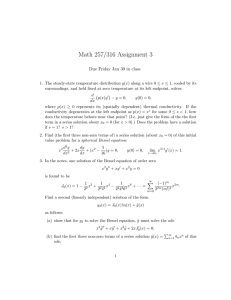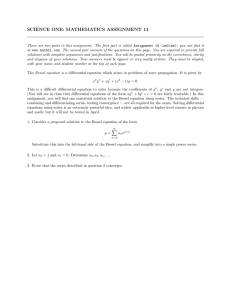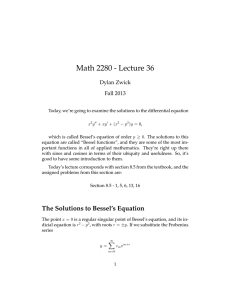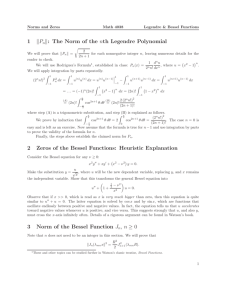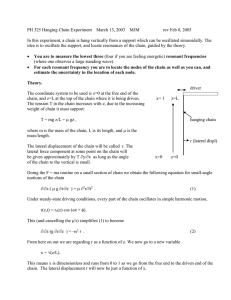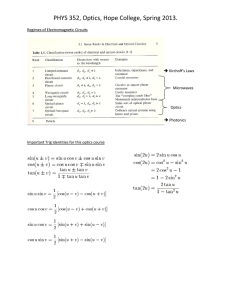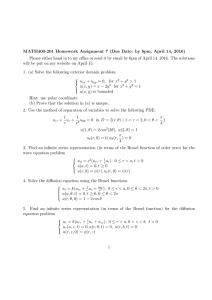Math 2280 - Lecture 36 Dylan Zwick Fall 2013
advertisement
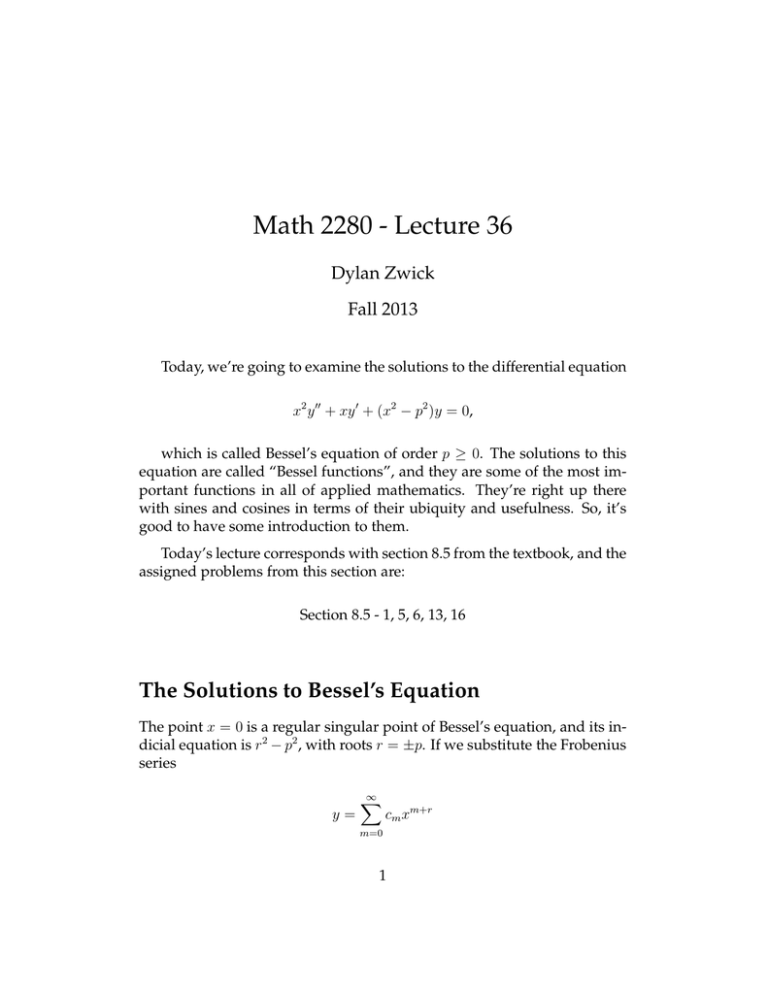
Math 2280 - Lecture 36 Dylan Zwick Fall 2013 Today, we’re going to examine the solutions to the differential equation x2 y ′′ + xy ′ + (x2 − p2 )y = 0, which is called Bessel’s equation of order p ≥ 0. The solutions to this equation are called “Bessel functions”, and they are some of the most important functions in all of applied mathematics. They’re right up there with sines and cosines in terms of their ubiquity and usefulness. So, it’s good to have some introduction to them. Today’s lecture corresponds with section 8.5 from the textbook, and the assigned problems from this section are: Section 8.5 - 1, 5, 6, 13, 16 The Solutions to Bessel’s Equation The point x = 0 is a regular singular point of Bessel’s equation, and its indicial equation is r 2 − p2 , with roots r = ±p. If we substitute the Frobenius series y= ∞ X cm xm+r m=0 1 into Bessel’s equation we find in the usual manner that c1 = 0 and that our coefficients must satisfy the recusion relation: [(m + r)2 − p2 ]cm + cm−2 = 0 for m ≥ 2.1 For the case r = p if we write am in place of cm then as a1 = 0 the relation above gives us that all odd coefficients are 0, while the even cofficients are given by the recursion relation: am = − am−2 . m(2p + m) If we write out the first few terms of this sequence we get: a0 = a0 , a0 a2 = − 2 , 2 (p + 1) a0 a2 = 4 , a4 = − 4(2p + 4) 2 · 2(p + 1)(p + 2) a4 a0 a6 = − =− 6 , 6(2p + 6) 2 · 2 · 3(p + 1)(p + 3) and the general pattern is a2m = (−1)m a0 . 22m m!(p + 1)(p + 2) · · · (p + m) So, for the root r = p we get the solution y1 (x) = a0 1 ∞ X (−1)m x2m+p . 22m m!(p + 1)(p + 2) · · · (p + m) m=0 You will derive this as a homework problem. 2 As for the root r = −p, we have the recursion relation (where we write bm in place of cm ): bm = − bm−2 . m(m − 2p) If p is not a positive integral multiple of 12 there is no issue here. If p is a positive integral multiple of 12 then we might have a problem. If it’s an odd positive integral multiple then, as all the coefficients bm must be 0 when m is odd there is no problem. If p is a positive integer, then we got problems. We’ll deal with these problems shortly, but first we state that if p is not an integer then we get the second solution: y2 (x) = b0 ∞ X (−1)m x2m−p . 22m m!(−p + 1)(−p + 2) · · · (−p + m) m=0 Now, recall from lecture 26 that the gamma function is defined as: Γ(x) = Z ∞ e−t tx−1 dt, 0 and has the properties Γ(x + 1) = xΓ(x), Γ(n + 1) = n! if n is a positive integer. Now, technically the gamma function is only here defined for values of x > 0. However, we can extend the definition of the gamma function to negative values that are not integers using the relation Γ(x + 1) = xΓ(x). With the aid of the gamma function we define the Bessel functions of the first kind of order p as: Jp (x) = ∞ X x 2m+p (−1)m . m!Γ(p + m + 1) 2 m=0 3 If p is not a negative integer, then the solution to Bessel’s equation can be written as: y(x) = c1 Jp (x) + c2 J−p (x). If p is a positive integer then we only get one solution from our Frobenius series method, and we have to use the reduction of order method to find our second solution. This second solution is called a Bessel function of the second kind of integral order, and is given by: n−1 n−2m x 1 X 2 2 (n − m − 1)! Yn (x) = γ + ln − − π 2 π m=0 m!xn−2m ∞ 1 X (−1)m (Hm + Hm+n ) x n+2m , π m=0 m!(m + n)! 2 where γ is the Euler-Mascheroni constant2 and Hn represents the sum of the first n terms in the harmonic series. Yeah, deriving this is a pain, and I don’t expect you to memorize it, or even use it. I just wanted you to see it. If p is an integer n then the solution to Bessel’s equation is: y(x) = c1 Jn (x) + c2 Yn (x). Bessel Function Identities Like trigonometric functions, Bessel functions satisfy a number of useful identities. In particular, the following identities can be derived using termwise differentiation and then a little algebra: 2 Whether this constant is irrational (it probably is) is still an open question in mathematics. 4 p Jp′ (x) = Jp−1 (x) − Jp (x), x p Jp′ (x) = Jp (x) − Jp+1 (x), x 2p Jp+1 (x) = Jp (x) − Jp−1 (x), x 2p Jp−1 (x) = Jp (x) − Jp+1 (x). x Example - Express the function J3 (x) in terms of the functions J0 (x) and J1 (x). 5 Notes on Homework Problems We’ve spent this section, really, only solving one differential equation! So, there aren’t a lot of differential equations to solve in this homework. Instead, the homework for this section, like the section itself, if about exploring Bessel functions. Problem 8.5.1 asks you to differentiate the Bessel function J0 (x) termwise to find a relation between the function’s derivative and the function J1 (x). Problem 8.5.5 asks you to express J4 (x) in terms of J0 (x) and J1 (x). It’s very similar to the example problem above. Problem 8.5.6 asks you to derive the recursion formula we used to define Bessel functions. Not too bad. Problems 8.5.13 and 8.5.16 require that you use the Bessel function identitiesZ to express certain integrals of Bessel functions in terms of the integral J0 (x). This integral cannot be simplified further, but it has been studied in substantial depth. 6
